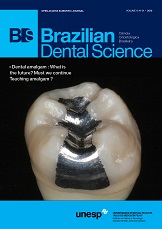Regression of large periapical lesion using calcium hydroxide therapy: a six-year follow-up case report
DOI:
https://doi.org/10.14295/bds.2015.v18i1.1015Abstract
Periradicular lesions occur in non-vital teeth as the result of a chronic aggression by the presence of microorganisms into the root canal, which may appear as a radiolucent lesion in the radiographic exam; treatment varies according to surgical or nonsurgical methods. This case report describes the regression of a periradicular lesion using a nonsurgical endodontic treatment in association with intracanal calcium hydroxide-based medicament. After patient examination and radiographic analysis, a 13 mm (in maximum diameter) radiolucent lesion was observed in tooth number 12. The endodontic treatment was done and Calen-CMCP (S.S. White Artigos Dentários Ltda., Rio de Janeiro, RJ, Brazil) was placed into the root canal, which was changed after every two weeks during two months. It was observed a progressive centrifugal regression of the lesion after every renewing of the medicament. In addition, after six-year follow-up the tooth was still free of re-infection and bone tissue was completely regenerated. In conclusion, calcium hydroxide therapy can conservatively stimulate the regression of large periradicular lesions.Downloads
Downloads
Additional Files
Published
How to Cite
Issue
Section
License
Brazilian Dental Science uses the Creative Commons (CC-BY 4.0) license, thus preserving the integrity of articles in an open access environment. The journal allows the author to retain publishing rights without restrictions.
=================




























